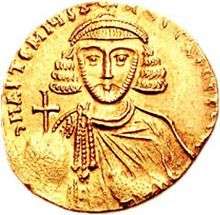Anastasios II
Anastasios II (Greek: Ἀναστάσιος Β΄, latinised Anastasius II, died 719), was the Byzantine Emperor from 713 to 715.
| Anastasius II | |
|---|---|
| Emperor of the Romans | |
 A coin of Anastasius II | |
| Emperor of the Byzantine Empire | |
| Reign | 3 June 713 – November 715 |
| Predecessor | Philippicus Bardanes |
| Successor | Theodosius III |
| Died | November 719 |
| Twenty Years' Anarchy | |||
|---|---|---|---|
| Chronology | |||
|
|||
| Succession | |||
|
|||
Biography
Anastasios was originally named Artemius (Ἀρτέμιος, Artemios) and had served as a bureaucrat and Imperial secretary (asekretis) for his predecessors. After the Opsician army in Thrace had overthrown Emperor Philippikos Bardanes (Philippicus), they acclaimed Artemius as Emperor. He chose Anastasius as his regnal name. Soon after his accession, Anastasius II imposed discipline on the army and executed those officers who had been directly involved in the conspiracy against Philippikos.
Anastasios upheld the decisions of the Sixth Ecumenical Council and deposed the Monothelete Patriarch John VI of Constantinople, replacing him with the orthodox Patriarch Germanus in 715. This also put an end to the short-lived local schism with the Catholic Church.
The advancing Umayyad Caliphate surrounded the Empire by land and sea (they penetrated as far as Galatia in 714), and Anastasios attempted to restore peace by diplomatic means. His emissaries having failed in Damascus, he undertook the restoration of Constantinople's walls and the rebuilding of the Roman fleet. However, the death of the Caliph al-Walid I in 715 gave Anastasius an opportunity to turn the tables on his rival. He dispatched an army under Leo the Isaurian, afterwards emperor, to invade Syria, and he had his fleet concentrate on Rhodes with orders not only to resist the approach of the enemy but to destroy their naval stores.[1]
These troops of the Opsician theme, resenting the Emperor's strict measures, mutinied, slew the admiral John, and proclaimed as emperor Theodosius III (Theodosios), a tax-collector of low extraction. After a six-month siege, Constantinople was taken by Theodosius; Anastasios, who had fled to Nicaea, was eventually compelled to submit to the new emperor in 716 and retired to a monastery in Thessalonica.[2]
In 719, Anastasios headed a revolt against Leo III, who had succeeded Theodosius, receiving considerable support, including auxiliaries reportedly provided by Tervel of Bulgaria. However the chronicler Theophanes the Confessor, who offers this information elsewhere, confuses Tervel with his eventual successor Kormesiy, so perhaps Anastasios was allied with the younger ruler. In any case, the rebel forces advanced on Constantinople. The enterprise failed, and Anastasios fell into Leo's hands and was put to death by his orders.[1]
See also
References
- Chisholm 1911.
-

Sources
- Ostrogorsky, George (1956). History of the Byzantine State. Oxford: Basil Blackwell.CS1 maint: ref=harv (link)
- The Oxford Dictionary of Byzantium, Oxford University Press, 1991.
External links
![]()
| Regnal titles | ||
|---|---|---|
| Preceded by Philippikos Bardanes |
Byzantine Emperor 3 June 713 – November 715 |
Succeeded by Theodosius III |